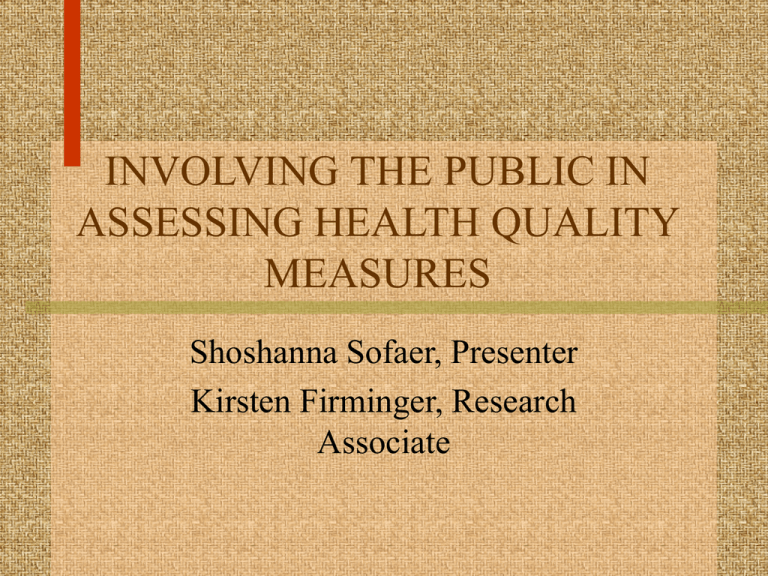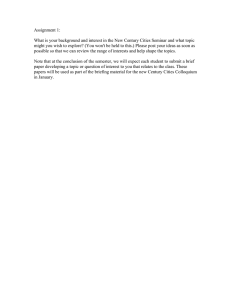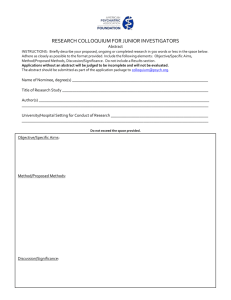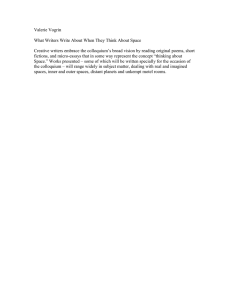INVOLVING THE PUBLIC IN ASSESSING HEALTH QUALITY MEASURES Shoshanna Sofaer, Presenter
advertisement

INVOLVING THE PUBLIC IN ASSESSING HEALTH QUALITY MEASURES Shoshanna Sofaer, Presenter Kirsten Firminger, Research Associate PRESENTATION OVERVIEW • • • • • • Project Research Team Methods Findings Implications The Sequel December 2 2009 School of Public Affairs Faculty Colloquium 2 THE PROJECT • • • “Developing and testing nursing quality measures with consumers and patients” Funded by the Interdisciplinary Nursing Quality Research Initiative (INQRI) of the Robert Wood Johnson Foundation Project had three aims; we will focus on the first: Gauge public response to 15 nursing sensitive quality measures endorsed by the National Quality Forum (NQF) December 2 2009 School of Public Affairs Faculty Colloquium 3 The Interdisciplinary Research Team • • • Shoshanna Sofaer, DrPH, Baruch College School of Public Affairs (Baruch), Principal Investigator Jean Johnson, PhD, RN, FAAN, George Washington University School of Medicine and Health Sciences (GW), Co-Principal Investigator Ellen Dawson, PhD, RN, ANP (GW), CoPrincipal Investigator December 2 2009 School of Public Affairs Faculty Colloquium 4 The Interdisciplinary Research Team • • • • Kirsten Firminger, doctoral candidate, (Baruch) Christine Pintz, PhD, RNC(GW) Andrea Brassard, DNSc, MPH, ANP(GW) Kirsten and Christine actually ran the focus groups we describe, coded the transcripts, and analyzed the quantitative and qualitative data December 2 2009 School of Public Affairs Faculty Colloquium 5 Background/Motivation • • • Public reporting of quality measures is on the rise, but many public reports are not looked at, not understood and not used by the intended audience We know that unless quality measures resonate with the public, are easy to understand and apply, they will not influence behavior Yet many measures that meet technical criteria have not been tested with the public December 2 2009 School of Public Affairs Faculty Colloquium 6 Background/Motivation • • • • The National Quality Forum is a non-profit membership organization governed by multiple health care stakeholders They utilize a complex process to reach consensus across stakeholders on health care quality measures that meet certain criteria (next slide) When consensus is reached, the measures are “endorsed” Many major sponsors of health care quality reporting will only publicly report NQF endorsed measures, including the Centers for Medicare & Medicaid Services December 2 2009 School of Public Affairs Faculty Colloquium 7 Background/Motivation • The criteria used by NQF are: – Importance to Measure and Report to make significant gains in healthcare quality and improve health outcomes – Scientific Acceptability of Measure Properties, i.e. validity and reliability – Usability by intended audiences (e.g. consumers, purchasers, providers, policy makers) i.e. can understand and would find useful in decision making – Feasibility of data collection without undue burden December 2 2009 School of Public Affairs Faculty Colloquium 8 Background/Motivation • • However, while extensive documentation is required about the scientific reliability and validity of measures, and feasibility of data collection, no documentation is required to demonstration the usability of measures to a major audience for public quality reports: consumers Instead, NQF relies on the views of members who are considered to be “representing” consumers, such as the AARP, the AFL-CIO, etc. December 2 2009 School of Public Affairs Faculty Colloquium 9 Background/Motivation • • • This research was designed to investigate the hypothesis that at least some endorsed measures are, when actually tested with consumers, less than usable We hoped that if our hunch proved accurate, we could use our results to influence the process by which NQF endorses measures going forward The focus of our work was a set of 15 measures that were endorsed by NQF as being “nursing sensitive” hospital quality measures: the NQF 15 December 2 2009 School of Public Affairs Faculty Colloquium 10 Research Methods • We conducted 9 focus groups with recently hospitalized patients to determine if participants: – Could understand and interpret the NQF 15 – Found these measures significant in the light of their hospital experiences – Thought the measures related to the roles, responsibilities and functions of nurses in particular December 2 2009 School of Public Affairs Faculty Colloquium 11 Research Methods • Sampling: – Three groups each in DC, Chicago and Phoenix – Three groups each with people who used OB, medical and surgical services – Participants recruited to vary in age, gender, race/ethnicity, education level December 2 2009 School of Public Affairs Faculty Colloquium 12 Research Methods • • • To maximize understanding of measures, we developed more user friendly language for the NQF 15 (see handout) To ensure comprehension of the task, we presented slides on quality measures To gauge understanding, we asked participants to explain the measure in their own words December 2 2009 School of Public Affairs Faculty Colloquium 13 Research Methods • Participants silently rated each measure on their: – Importance – Likelihood of variation in performance across nurses and hospitals – Whether a very high or low score would lead them to reconsider their hospital choice • After each rating, participants discussed their responses and reasons for their ratings in depth December 2 2009 School of Public Affairs Faculty Colloquium 14 Findings • On silent ratings, at least 80% of participants found the following measures very important: – Failure to rescue – Pressure ulcers – UTI among catheterized patients – Central line infections – Pneumonia among patients on ventilators – Positive nursing work environment December 2 2009 School of Public Affairs Faculty Colloquium 15 Findings • • Ratings showed participants were least responsive to three measures about whether nurses advised patients to stop smoking Group discussion generated these reasons: – – – – Nurses have better things to do with their time Patients already know they shouldn’t smoke Smoking is the patient’s responsibility Nurses who are obviously not models of healthy behavior are not credible as messengers to adopt them December 2 2009 School of Public Affairs Faculty Colloquium 16 Findings • Many participants were ambivalent about the measures relating to falls and restraints – Who is responsible when patients fall, the nurse or the patient? – Don’t some patients need to be restrained? – Do nurses sometimes restrain patients as “retribution”? – Won’t some patients fall if they aren’t restrained? December 2 2009 School of Public Affairs Faculty Colloquium 17 Findings • • • • Measures of nurse-patient staffing ratios, nursing mix and turnover rates, confused many Nursing mix: What’s good? Measure doesn’t “point to” the answer Nurse-patient ratio: Of great interest, but the measure was just not clear enough to consumers “Rate at which nursing staff voluntarily end their employment” – does this mean the turnover rate? the number of vacancies? December 2 2009 School of Public Affairs Faculty Colloquium 18 Findings • • • • More broadly, these patients are fully aware of the centrality of nurses to their hospital experience They realize that in many cases, nurses share responsibility with others, including physicians and patients More than anything, people want the nurse to “be there” and to “be competent” We can’t assume consumers know the “evidence base” underlying the measures, for example that restraints actually increase rather than reduce falls December 2 2009 School of Public Affairs Faculty Colloquium 19 Implications • • • Does this lack of expertise mean we shouldn’t bother asking the public their views? NO! The public has much to contribute to assessing quality measures Yet at the time of the study, NQF endorsed measures even if there was no evidence of the public’s response to them December 2 2009 School of Public Affairs Faculty Colloquium 20 Implications • Getting public input before endorsement has these benefits: – Professional judgments about the absolute and relative importance of individual measures will be either reinforced or seriously questioned – Issues of attribution of responsibility will be surfaced – Problems in measure specification that lead to potential confusion can be resolved December 2 2009 School of Public Affairs Faculty Colloquium 21 Implications • We can get guidance about – When we need to explain the evidence base to “legitimate” a measure – What kind of “contextual” information will be needed if measures are to be publicly reported – We can learn what else the public cares about with respect to a particular issue December 2 2009 School of Public Affairs Faculty Colloquium 22 The Sequel • • • NQF always takes measures through a periodic review process; this took place in 2008-09 with the NQF 15 We were able to present our findings in detail to NQF staff, to the Hospital Quality Alliance, as well as to many nursing and health services researcher As a result of this, and the review process, the smoking measures are gone, the measures the public liked most remain, and other measures are being tweaked December 2 2009 School of Public Affairs Faculty Colloquium 23 The Sequel • • • • NQF has said they are moving toward changing their requirements for measures It remains to be seen if this will happen and what it will look like The good news: people involved with the review welcomed getting the kind of information we provided, and were surprised at how much it revealed The remaining question: no one questions spending money on statistical field testing of measures; will they find the resources to do careful consumer testing as well? December 2 2009 School of Public Affairs Faculty Colloquium 24


